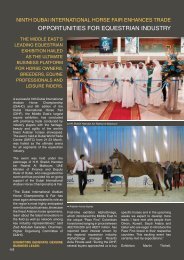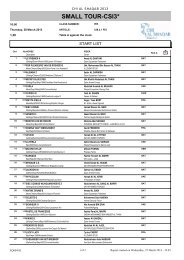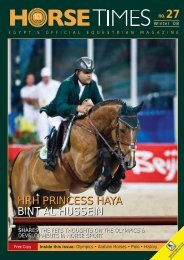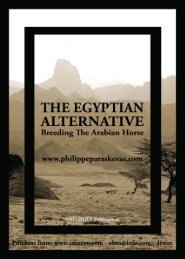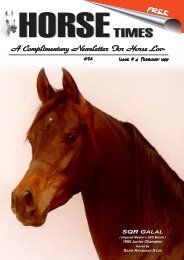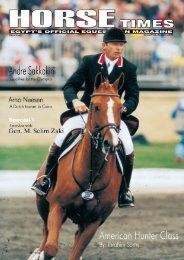HIDALGO & FRANK HOPKINS HORSES IN HISTORY ... - Horse Times
HIDALGO & FRANK HOPKINS HORSES IN HISTORY ... - Horse Times
HIDALGO & FRANK HOPKINS HORSES IN HISTORY ... - Horse Times
You also want an ePaper? Increase the reach of your titles
YUMPU automatically turns print PDFs into web optimized ePapers that Google loves.
50<br />
World's Fair in 1889, Rau Rasmussen, a<br />
lover of fine horses, approached him and<br />
a businessman who dominated most of<br />
the camel freighting around Aden on the<br />
southern tip of Arabia. Rasmussen spoke<br />
to Hopkins, telling him of an endurance<br />
ride that was held in Arabia each year, as<br />
it had been for 1.000 years. Only desertbred<br />
Arabians had ever competed in the<br />
long trek. But Rasmussen had heard of<br />
the prairie mustangs, those scrubby,<br />
coarse-looking horses which had outrun<br />
the fastest horses the frontier cavalry had<br />
mustered against mounted Indians. He<br />
asked Hopkins if he would be willing to<br />
pit one of his mustangs against Arabian<br />
horses. With the financial support of the<br />
Congress of Rough Riders of the World,<br />
Hopkins' acceptance immediately stirred<br />
keen interest in cavalry and civilian horse<br />
circles throughout the world. Hopkins<br />
arrived in Arabia in 1890 for the endurance<br />
race, bringing with him 3 horses; Hidalgo,<br />
then 8 years old, was Hopkins' final choice<br />
for the ride. Slightly over 100 horses<br />
started on the ride from Aden. The great<br />
caravan of skilled Arabian riders rode their<br />
most prized mounts. They were spirited,<br />
accustomed to the difficulty of traversing<br />
the sands, and accustomed to the sun<br />
that sprayed exhausting heat upon them.<br />
Even among the mass of mounted<br />
horsemen, Hopkins stood out with particoloured,<br />
950-pound Hidalgo from the<br />
American plains. Hopkins held Hidalgo<br />
at a steady pace as they made their way<br />
through the dry heat and over sandy soil.<br />
The march progressed to the Persian Gulf<br />
and up toward Syria and then along the<br />
border of Syria and Arabia. Each day the<br />
riders started with the sun, following it<br />
until they were marching into it. <strong>Horse</strong>s<br />
dropped by the way, some exhausted,<br />
some lame. At the end of the first week,<br />
the scarcity of water and the meager diet<br />
the horses were forced to exist upon in<br />
the barren country had culled the<br />
inadequate horses.<br />
The strung line of riders dwindled daily.<br />
Entering the second week of the gruelling<br />
trek, Hopkins made his move and started<br />
to pass the other desert riders. In the<br />
Hopkins & parti-coloured Hidalgo walking the deserts of Arabia<br />
wake of the sand kicked up by Hidalgo,<br />
treasured Arabian horses of the Bedouins<br />
fell farther and farther behind, while Hidalgo<br />
kept to a steady pace.<br />
On the 66th day of the ride Hopkins rode<br />
Hidalgo to the finish stone, leaving behind<br />
him 3.000 scorching miles. Hidalgo had<br />
lost considerable weight, drawing his pinto<br />
hide close to his bones. Hopkins had him<br />
well rested and fed when the second horse<br />
arrived 33 hours later. The Arabs praised<br />
Hidalgo for the distinction he had won. He<br />
had lived up to his name “exceptional,”<br />
“exalted.”<br />
The story of Hidalgo is still mentioned<br />
among Arabian horse enthusiasts, but<br />
always with the conjecture, was Hidalgo<br />
an exceptional horse? Did he, as the<br />
typical representative of the mustangs of<br />
the American plains show superiority over<br />
the most acclaimed breed in the world,<br />
the Arabian horse? HT



